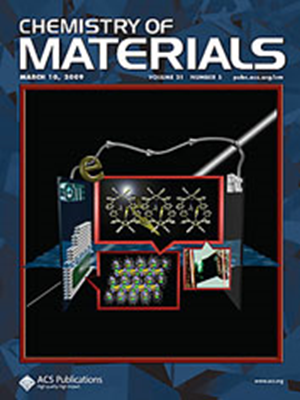Correction to “An Air-Stable and Exfoliable Ferromagnetic Two-Dimensional Perovskite, (Phenethylammonium)2CrCl4”
IF 7
2区 材料科学
Q2 CHEMISTRY, PHYSICAL
引用次数: 0
Abstract
The authors regret an error in the reported orientation of the magnetic easy axis of (PEA)2CrCl4. The original report stated that the magnetic easy axis was oriented in the ab plane, bisecting the angle defined by the a and b axes, but the correct orientation is bisecting the Cr2+ molecular axes. The following corrections are required in the text: Page 1574, paragraph 2, sentence 2 now reads, “Figure 5a plots field-cooled (FC) and zero-field-cooled (ZFC) molar susceptibility (χ) vs temperature for a single crystal with a 0.01 T magnetic field oriented in the crystallographic ab plane (H ⊥ c), bisecting the angle defined by the Cr2+ molecular axes (φ = 45°).” Page 1574, paragraph 2, sentence 5 now reads, “Magnetic measurements with the field oriented perpendicular to the ab plane (H || c) show a similar temperature dependence but much smaller χ (Figure 5b), and those with the magnetic field oriented along the Cr–Cl bonds (H ⊥ c, φ = 0° or 90°) also show small χ (Figure S7).” Page 1574, paragraph 2, sentence 6 now reads, “These data indicate in-plane magnetic ordering with easy axes bisecting the angles defined by the Cr2+ molecular axes, parallel to the a or b crystallographic axes, as illustrated in the inset of Figure 5c.” Figure 5. Magnetic data for a (PEA)2CrCl4 single crystal. (a) Field-cooled (FC) and zero-field-cooled (ZFC) susceptibility, measured with H = 0.01 T applied in the ab plane (H ⊥ c), bisecting the angle defined by the Cr2+ molecular axes (φ = 45°). The inset shows the derivative of the FC data, yielding an ordering temperature of TC = 44 K. (b) FC and ZFC susceptibility data collected with an applied magnetic field oriented perpendicular to the crystallographic ab plane and parallel to the c axis (H || c). (c) Field-sweep magnetization data measured from −14 to +14 T at different temperatures. The inset illustrates the in-plane magnetic-field (H ⊥ c, φ = 45°) orientation, coinciding with a magnetic easy axis. (d) An expanded view of the data from Figure 5c, showing magnetic hysteresis at low temperatures. The inset in Figure 5c and text in Figure S7d also require correction. The corrected figures and captions are included below. The authors apologize for any confusion caused. The Supporting Information is available free of charge at https://pubs.acs.org/doi/10.1021/acs.chemmater.4c03441. Corrected Figure S7 (PDF) Most electronic Supporting Information files are available without a subscription to ACS Web Editions. Such files may be downloaded by article for research use (if there is a public use license linked to the relevant article, that license may permit other uses). Permission may be obtained from ACS for other uses through requests via the RightsLink permission system: http://pubs.acs.org/page/copyright/permissions.html. This article has not yet been cited by other publications.

对“一种空气稳定且可剥落的铁磁性二维钙钛矿,(苯乙基铵)2CrCl4”的修正
作者对(PEA)2CrCl4磁易轴方向的报道有误表示遗憾。原来的报道指出磁易轴在ab平面上定向,将a轴和b轴定义的角度平分,但正确的定向是将Cr2+分子轴平分。文本中需要进行以下更正:第1574页,第2段,第2句现在是,“图5a绘制了场冷(FC)和零场冷(ZFC)的摩尔磁化率(χ)与温度的关系,单晶具有0.01 T的磁场,取向于晶体学ab平面(H⊥c),将Cr2+分子轴定义的角度(φ = 45°)分二。”第1574页,第2段,第5句现在是,“垂直于ab平面的磁场测量(H || c)显示出类似的温度依赖性,但更小的χ(图5b),而沿着r - cl键的磁场测量(H⊥c, φ = 0°或90°)也显示出小的χ(图S7)。”第1574页,第2段,第6句现在是,“这些数据表明平面内磁有序,简单的轴平分由Cr2+分子轴定义的角度,平行于a或b晶体轴,如图5c所示。”图5。(PEA)2CrCl4单晶的磁性数据。(a)场冷(FC)和零场冷(ZFC)磁化率,用H = 0.01 T在ab平面(H⊥c)上测量,将由Cr2+分子轴定义的角度(φ = 45°)对分。插图显示了FC数据的导数,得到的有序温度为TC = 44 k。(b)在垂直于晶体学ab面并平行于c轴(H || c)的外加磁场下收集的FC和ZFC磁化率数据。(c)在不同温度下从- 14到+14 T测量的场扫描磁化数据。插图说明了面内磁场(⊥c, φ = 45°)的方向,与磁易轴重合。(d)图5c数据的扩展视图,显示低温下的磁滞。图5c中的插入和图S7d中的文本也需要更正。更正后的数字和说明如下。作者对造成的任何混乱表示歉意。支持信息可在https://pubs.acs.org/doi/10.1021/acs.chemmater.4c03441免费获取。更正图S7 (PDF)大多数电子支持信息文件无需订阅ACS网络版即可获得。这些文件可以通过文章下载用于研究用途(如果相关文章有公共使用许可链接,该许可可以允许其他用途)。如有其他用途,可通过RightsLink权限系统http://pubs.acs.org/page/copyright/permissions.html向ACS申请。这篇文章尚未被其他出版物引用。
本文章由计算机程序翻译,如有差异,请以英文原文为准。
求助全文
约1分钟内获得全文
求助全文
来源期刊

Chemistry of Materials
工程技术-材料科学:综合
CiteScore
14.10
自引率
5.80%
发文量
929
审稿时长
1.5 months
期刊介绍:
The journal Chemistry of Materials focuses on publishing original research at the intersection of materials science and chemistry. The studies published in the journal involve chemistry as a prominent component and explore topics such as the design, synthesis, characterization, processing, understanding, and application of functional or potentially functional materials. The journal covers various areas of interest, including inorganic and organic solid-state chemistry, nanomaterials, biomaterials, thin films and polymers, and composite/hybrid materials. The journal particularly seeks papers that highlight the creation or development of innovative materials with novel optical, electrical, magnetic, catalytic, or mechanical properties. It is essential that manuscripts on these topics have a primary focus on the chemistry of materials and represent a significant advancement compared to prior research. Before external reviews are sought, submitted manuscripts undergo a review process by a minimum of two editors to ensure their appropriateness for the journal and the presence of sufficient evidence of a significant advance that will be of broad interest to the materials chemistry community.
 求助内容:
求助内容: 应助结果提醒方式:
应助结果提醒方式:


